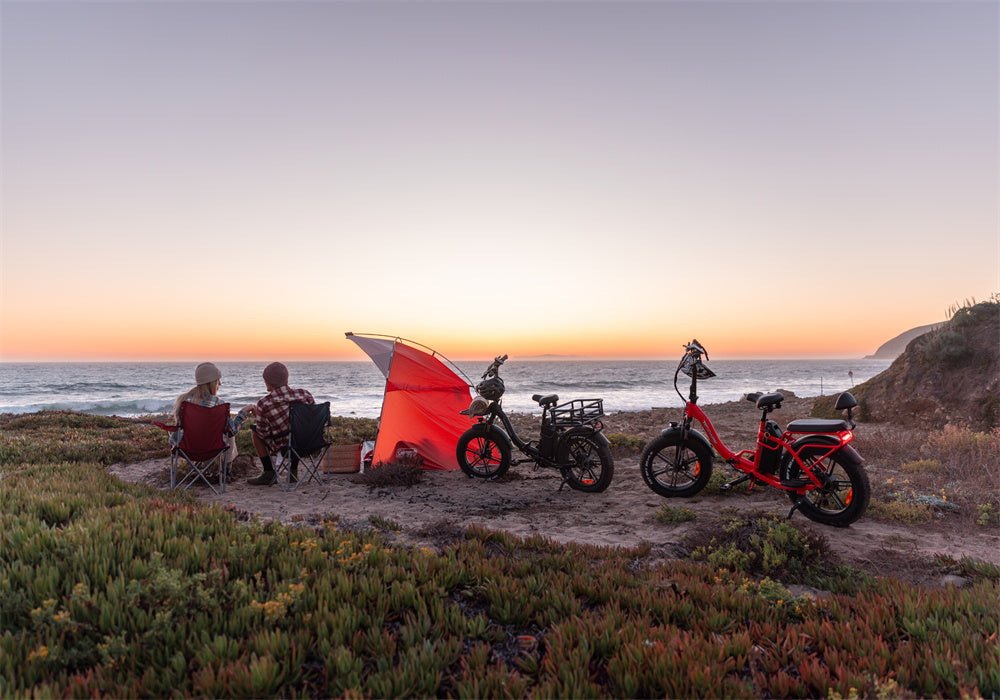There are suitable electric bikes for most people of average weight. But for heavier riders, finding a suitable bike involves more factors to consider. For instance, you need to think about the load-bearing capacity of the electric bike. In fact, bicycles also have their own load limits. People with heavier weights don’t need to worry, you could still find an electric bicycle that suits them.
Is There a Weight Limit for Bikes?
Most bikes do have weight limits. The bike weight limit varies depending on the type and construction of the bike. Manufacturers typically set these limits to ensure rider safety and maintain optimal bike performance. The standard road bikes usually support up to 220-250 pounds, while some heavy-duty or specialty bikes can accommodate more weight.

Why Weight Limits Matter
Safety is a primary concern; exceeding the weight limit can compromise the bike's structural integrity, leading to accidents. When a bike is overloaded, it may experience frame fractures, wheel deformities, and compromised brake performance, which can result in dangerous situations.
Performance is significantly impacted by weight. Overloading a bike can affect its handling, speed, and overall performance. A bike designed for lighter loads may not perform well under excessive weight, making it harder to control and maneuver.
Durability is an important factor. Riding a bike beyond its weight capacity can cause excessive wear and tear, reducing its lifespan. Components such as the tires, spokes, and gears may wear out faster, requiring more frequent repairs and replacements. Understanding and adhering to the bike weight limit is essential for a safe and enjoyable riding experience.
Riders should always check the manufacturer's specifications and ensure that their weight, including any gear or accessories, does not exceed the recommended limits.

How Much Does a Bike Weigh
The weight of a bike can vary significantly based on its type, materials, and intended use. Knowing the average weight can help you choose a bike that suits your needs, especially if you're considering bikes for plus size riders.
Average Bike Weights
Road bikes typically weigh between 15-25 pounds, designed for speed and agility on paved surfaces. These bikes are built with lightweight materials such as aluminum or carbon fiber, making them ideal for racing and long-distance rides.
Mountain bikes usually weigh between 25-35 pounds, built for durability and performance on rough terrain. These bikes have sturdy frames and wider tires to handle off-road conditions, and they often include suspension systems to absorb shocks.
Hybrid bikes combine features of road and mountain bikes, weighing around 20-30 pounds. They offer versatility for both urban commuting and light trail riding. Electric bikes weigh more due to the battery and motor, generally ranging from 40-70 pounds.
Ebikes provide pedal assistance, making them suitable for longer rides and hilly terrains, but their additional components add to the overall weight.
For men handling heavier weights, an elctric bicycle is a great option. Check out the TESWAY X5, which can carry up to 350 pounds and reach speeds of 28 mph. It features a powerful 750W motor and is foldable, making it ideal for those with limited storage space.
If folding ebikes aren't your thing, consider the TESWAY S7. It's a large bike motorizd with wide tires and a portable 960WH battery. It also has a 750W motor and 70N of torque, providing a robust and reliable ride.
Factors Affecting Bike Weight
The choice of materials plays a significant role in determining the bike's weight.
Aluminum is a popular choice for its lightweight and affordability. Steel, while heavier, offers excellent durability and a smoother ride, making it a common choice for touring and vintage bikes.
Carbon fiber is extremely light and strong, but more expensive, often used in high-end road and mountain bikes. Titanium is another lightweight and durable material, providing a smooth ride quality, typically seen in premium bikes.

What Parts Will Affect the Weight of the Bike
The weight of a bike is influenced by various components, each playing a significant role in its overall mass. If you're looking for a bike that supports a higher bicycle weight,these factors following you should consider.
Frame Material
Aluminum frames are lightweight and affordable, commonly used in entry-level to mid-range bikes.
Steel frames are heavier but offer excellent durability and a smoother ride, often found in touring and vintage bikes.
Carbon fiber frames are extremely light and strong, but more expensive, popular in high-end road and mountain bikes. Titanium frames are lightweight and durable, with a smooth ride quality, usually seen in premium bikes.
Wheels and Tires
Larger wheels can add weight but provide better stability and roll-over capability. Thicker, wider tires weigh more but offer increased traction and comfort, essential for off-road and plus-size biking. The type of rims used can also impact the weight; double-walled rims, for example, are heavier but offer better strength and durability.
Components and Accessories
Components such as the drivetrain, brakes, and suspension systems contribute to the bike's overall weight. The gears, chain, and derailleurs add weight, with more complex systems being heavier. Disc brakes weigh more than rim brakes but offer superior stopping power, especially under load. Suspension systems in mountain bikes add weight but improve ride quality on rough terrain. Other accessories like racks, fenders, and lights can also increase the bike's weight.

What Is the Maximum Weight of a Bicycle
How heavy bicycle? Most manufacturers provide guidelines of average weight bike to ensure safety and performance.
Road bikes typically support riders up to 220-250 pounds. These bikes are designed for speed and efficiency on paved surfaces, with lightweight frames and components that prioritize agility.
Mountain bikes can accommodate slightly more, usually up to 300 pounds. Built for rugged terrain, these bikes feature stronger frames, wider tires, and robust suspension systems to handle rough conditions. Hybrid bikes generally support up to 250 pounds, offering a balance between the features of road and mountain bikes.
Electric bikes, depending on the model, can support up to 300-350 pounds due to their robust construction and motor assistance.
Ebikes are designed to provide additional power, making them suitable for a wider range of riders, including those who need extra support due to their weight
Excessive weight can cause frame damage, including cracks or breaks in the frame. Tires, brakes, and other components may wear out faster, leading to more frequent maintenance and higher repair costs. Handling and speed can be negatively affected, compromising the riding experience and making the bike harder to control. It's also important to consider the weight of any gear or accessories you carry, as these add to the overall load on the bike.

Cycle for Heavy Person
Looking for a bicycle for 300 lb man? You should do these.
Choosing the Right Bike
Heavy-duty bikes are specifically designed to support higher weights, featuring reinforced frames and components. These bikes are built to handle the additional stress, ensuring a safer ride for heavier individuals. Electric bikes can be an excellent option, offering motor assistance to make riding easier and more enjoyable. Ebikes provide extra power, which can be particularly beneficial for heavier riders who may struggle with uphill climbs or longer distances. Custom bikes are another option, with some manufacturers offering custom-built bikes tailored to your specific weight and riding preferences. Customization allows for a perfect fit and optimized performance, ensuring a comfortable and safe ride.
Key Features for Heavier Riders
When selecting a bike for overweight man, it's important to consider features that enhance safety and comfort. A strong frame made from materials such as steel or high-grade aluminum offers superior strength and durability. Robust wheels with double-walled rims and thicker spokes can handle more weight and provide better durability.
Comfortable saddles that are wider and well-padded can enhance comfort during longer rides. Additionally, suspension systems can help absorb shocks and provide a smoother ride on rough terrain. Ensuring that the bike has powerful brakes, such as disc brakes, is also crucial for safe stopping, especially when carrying extra weight.
Conclusion
At TESWAY, our bikes are crafted with lightweight and durable materials to support higher weight limits. Ensuring that you comply with the specified weight limits is crucial for maximum safety and performance. By choosing a bike that meets your weight requirements, you can enjoy a secure and comfortable ride every time.







Share:
How Fast Do Electric Bikes Go Without Pedaling
Ideal Electric Bike Battery For Longer And Smoother Rides